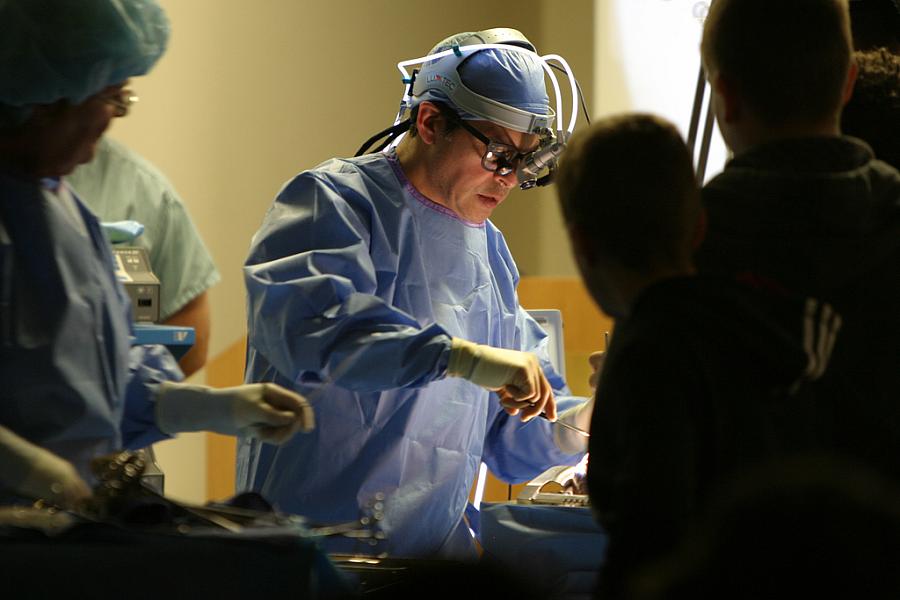Code Unknown: Parents weigh surgery to meet son's genetic challenge

PART FOUR (Read parts one, two, and three.)
Nathanael Dyer started suffering from migraines at a very young age.
He told his mom, Miranda, that the pain started in the center of his head and expanded outward, like it was filling up the inside of his skull, making it hard for him to think clearly and focus.
The migraines could last for weeks. After seeing a few doctors who couldn’t help, the family looked into treatments at the Mayo Clinic’s Florida campus. Eventually, the tests and questions about what was causing the headaches led to an echocardiogram (EKG).
The test is supposed to give doctors a clear reading of the pattern of electrical signals from a person’s heart.
When Nathanael was first given an EKG, everything appeared normal.
Then a specialist suggested Nathanael wear a heart monitor.
Dyer and her husband talked it through. Nathanael was only 8 years old at the time. He was an active kid and doing well in school despite the occasional absences because of the headaches. They knew that a heart monitor could be uncomfortable for him, or any kid.
No boy or girl wants to stand out in class because they have a medical condition. Other kids ask too many questions or can be just plain mean.
But the headaches were so persistent and seemed to be getting worse. They hoped the monitor would reveal some clues. After days of wearing it, though, nothing was revealed.
Then Miranda had her own revelation. The sperm donor who helped Miranda’s mother conceive may have passed on a genetic condition that was causing her heart’s rhythms to be out of balance. That same gene could have been passed on to Nathanael. A genetic test showed that she had the specific gene mutation that caused what is known as a long QT, the key symptom of a heart condition known as sudden arrhythmia death syndrome.
After Miranda’s gene test came back positive for the mutation, she had Nathanael and her two daughters visit a cardiologist. They all were given EKGs.
Once again, the tests came back normal.
Dyer wasn’t entirely surprised, because that’s what she’d been told repeatedly, too. “Don’t worry,” the doctors would say. “You’re young. Everything is OK.”
Dyer also had her children tested for the gene mutation. But before the genetic tests results came back, the children’s pediatrician asked the cardiologists to review the EKG results again in light of their mother’s gene test results.
“My pediatrician went into the doctor’s lounge and sat the EKGs in front of the cardiologists and said, ‘This is what the mother is dealing with, so please take a closer look.’” Dyer said. “Most cardiologists aren’t looking for something as subtle as this disorder. But if they know that they should be looking for it, they can tell if something’s there.”
That second review revealed that Nathanael showed signs of sudden arrhythmia death syndrome, like his mom. His 6-year-old sister Emily’s condition was less severe but still a potential problem.
“We removed Nathanael from sports,” Dyer said. “He wasn’t allowed to run. He had been a competitive swimmer on the swim team, but he had to leave the team.”
The gene testing for her had taken four months. For her children, though, the doctors were able to speed up the process. Three weeks later, the results came back.
One of her daughters tested negative for the gene that causes the disorder. But Nathanael and her daughter Emily had the gene. Test results in hand, they now faced difficult decisions.
Miranda and her husband, Jake, thought hard and prayed about whether to have Nathanael undergo surgery for a defibrillator as his mom had. Miranda’s surgery had been in February 2014, and she had not had any collapsing spells since the surgery.
But they had two major concerns about Nathanael. First, they were making a life-changing decision for him at a very young age. Miranda was able to decide for herself in her 30s to have the surgery, but they would be making a choice for Nathanael in which he really had no say. Second, they worried about whether the surgery itself would cause problems. All surgeries come with risks, as the surgeon explained. Did they want to take a chance that their son would get an infection, suffer another complication, or even die from a surgery?
They ended up making their decision in large part because of the odds. They knew that studies had shown there was a high likelihood that a person with this disorder would die prematurely. The thought of Nathanael going to sleep one night and not waking up was too much to bear.
So in April 2014, Nathanael had surgery to have a defibrillator put in. He has been doing well since then.
“These doctors saved the lives of myself and my kids,” Dyer said. “The potential pathways for a disease to move through a family tree are huge. This condition only stops when the condition doesn't get passed down. And we are so fortunate that we found it.”
But there was still the problem of those potential genetic pathways, which I’ll write about in a future post.
Photo by Eric Schmuttenmaer via Flickr.

